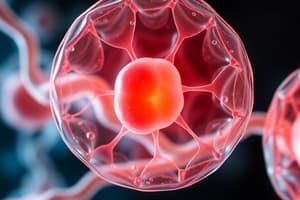Podcast
Questions and Answers
What is the name of the process where homologous chromosomes pair up during meiosis?
What is the name of the process where homologous chromosomes pair up during meiosis?
- Crossing Over
- Nondisjunction
- Synapsis (correct)
- Disjunction
What is the name of the process that randomly redistributes the genetic material during meiosis?
What is the name of the process that randomly redistributes the genetic material during meiosis?
- Disjunction (correct)
- Synapsis
- Nondisjunction
- Crossing Over
What is the primary type of cell division that results in the formation of gametes?
What is the primary type of cell division that results in the formation of gametes?
- Meiosis (correct)
- Binary Fission
- Budding
- Mitosis
Which of the following is NOT a numerical chromosomal abnormality?
Which of the following is NOT a numerical chromosomal abnormality?
What is the name of the condition where there is an extra copy of chromosome 21?
What is the name of the condition where there is an extra copy of chromosome 21?
Which syndrome is characterized by a numerical abnormality of 45 X0?
Which syndrome is characterized by a numerical abnormality of 45 X0?
Which of the following is a characteristic of Down Syndrome?
Which of the following is a characteristic of Down Syndrome?
What is the name of the condition that results from a non-disjunction event during meiosis?
What is the name of the condition that results from a non-disjunction event during meiosis?
What is the primary purpose of meiosis in the reproductive process?
What is the primary purpose of meiosis in the reproductive process?
Which event during meiosis results in genetic diversity among gametes?
Which event during meiosis results in genetic diversity among gametes?
What is the consequence of non-disjunction during meiosis?
What is the consequence of non-disjunction during meiosis?
How many chromosomes are present in a diploid human cell?
How many chromosomes are present in a diploid human cell?
Which of the following best describes Turner Syndrome?
Which of the following best describes Turner Syndrome?
What is the total number of chromosomes found in a typical male with Down Syndrome?
What is the total number of chromosomes found in a typical male with Down Syndrome?
What characterizes structural chromosomal abnormalities?
What characterizes structural chromosomal abnormalities?
What is the role of disjunction in meiosis?
What is the role of disjunction in meiosis?
Flashcards
Haploid Chromosomes
Haploid Chromosomes
Cells with 23 chromosomes, found in gametes.
Diploid Chromosomes
Diploid Chromosomes
Cells with 46 chromosomes, typical in somatic cells.
Mitosis
Mitosis
Cell division producing two identical daughter cells.
Meiosis
Meiosis
Signup and view all the flashcards
Aneuploidy
Aneuploidy
Signup and view all the flashcards
Down Syndrome
Down Syndrome
Signup and view all the flashcards
Turner Syndrome
Turner Syndrome
Signup and view all the flashcards
Non-Disjunction
Non-Disjunction
Signup and view all the flashcards
Autosomes
Autosomes
Signup and view all the flashcards
Sex Chromosomes
Sex Chromosomes
Signup and view all the flashcards
Meiosis II
Meiosis II
Signup and view all the flashcards
Chromosomal Abnormalities
Chromosomal Abnormalities
Signup and view all the flashcards
Trisomy 21
Trisomy 21
Signup and view all the flashcards
47 XXY
47 XXY
Signup and view all the flashcards
45 X0
45 X0
Signup and view all the flashcards
Study Notes
Gametogenesis, Implantation, Fetal Membranes and Placenta
- This lecture covers gametogenesis, implantation, and the development of fetal membranes and placenta.
- The class is Year 2, Semester 2, part of the Endocrine and Breast module.
- The lecturer is Dr. Vijayalakshmi SB, from the Department of Anatomy.
Chromosome Structure and Types
- Haploid chromosomes: Contains 23 chromosomes; these are the gametes (sperm and egg).
- Diploid chromosomes: Contains 46 chromosomes (23 pairs); these are found in somatic cells.
- Autosomes: Non-sex chromosomes; humans have 44 autosomes.
- Sex chromosomes: Determine the sex of an individual; humans have 2 sex chromosomes. Males have XY, females have XX.
Chromosome Structure Details
- Chromatid: One half of a duplicated chromosome.
- Chromosome: A structure containing DNA and proteins (histones).
- Centromere: The constricted region of a chromosome that holds sister chromatids together.
- p arm: The short arm of a chromosome.
- q arm: The long arm of a chromosome.
Cell Division: Mitosis and Meiosis
- Mitosis: The process where one cell divides into two identical daughter cells, essential for growth and repair.
- Meiosis: The cell division process resulting in gametes (sperm and egg). Involves two stages, Meiosis I & Meiosis II, reducing the diploid (46 chromosomes) number to haploid (23 chromosomes).
Meiosis I Details
- Synapsis: Homologous chromosomes pair up.
- Crossing over: Genetic material is exchanged between homologous chromosome pairs.
- Metaphase I: Homologous chromosome pairs align at the metaphase plate.
- Anaphase I: Homologous chromosomes separate and move to opposite poles.
- Telophase I: Nuclear envelopes may reform, and the cell divides.
Meiosis II Details
- No DNA duplication: Meiosis II divides the haploid cells into four genetically unique haploid cells with 23 chromosomes.
Clinical Correlates: Chromosomal Abnormalities
- Numerical abnormalities (Aneuploidy): A change in the number of chromosomes; either a decrease or increase in the number of chromosomes.
- Structural abnormalities: A defect in the structure of a chromosome, but the total chromosome number is normal.
- Non-disjunction: Failure of homologous chromosomes to properly separate during meiosis, a key cause of abnormal chromosome numbers. Trisomy 21 (Down Syndrome), 47,XXY (Klinefelter syndrome), and 45,XO (Turner syndrome) are associated with distinct characteristics and often result from non-disjunction. Non-disjunction can occur during either Meiosis I or Meiosis II.
Studying That Suits You
Use AI to generate personalized quizzes and flashcards to suit your learning preferences.




